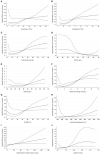Clinical Characteristics and Short-Term Outcomes of Severe Patients With COVID-19 in Wuhan, China
- PMID: 32850926
- PMCID: PMC7424035
- DOI: 10.3389/fmed.2020.00491
Clinical Characteristics and Short-Term Outcomes of Severe Patients With COVID-19 in Wuhan, China
Abstract
Background: A novel pneumonia (COVID-19) spread rapidly throughout worldwide, in December, 2019. Most of the deaths have occurred in severe and critical cases, but information on prognostic risk factors for severely ill patients is incomplete. Further research is urgently needed to guide clinicians, and we therefore prospectively evaluate the clinical outcomes of 114 severely ill patients with COVID-19 for short-term at the Union Hospital in Wuhan, China. Methods: In this single-centered, prospective, and observational study, we enrolled 114 severely ill patients with confirmed COVID-19 from Jan 23, 2020, to February 22, 2020. Epidemiological, demographic, laboratory, treatment, and outcome data were recorded, and the risk factors for poor outcome were analyzed. Results: Among the 114 enrolled patients with a mean age of 63.96 ± 13.41 years, 94 (82.5%) patients were classified as a good outcome group. Common clinical manifestations included fever, cough, and fatigue. Compared with the good outcome group, 20 (17.5%) patients in the poor outcome group more frequently exhibited lymphopenia, and lower levels of albumin, partial arterial oxygen pressure, higher levels of lactate dehydrogenase, creatine kinase, hypersensitive troponin I, C-reactive protein, ferritin, blood urea nitrogen, and D-dimer, as well as markedly higher levels of IL-6 and IL-10. Absolute numbers of T lymphocytes, CD8 + T cells, decreased in almost all the patients and were markedly lower in the poor outcome group than the good outcome group. We also found that traditional Chinese medicine can significantly improve the patient's condition, which is conducive to the transformation from a severe to mild condition. In addition, univariate and multivariate Cox analyses of potential factors for poor outcome patients indicated that cytokine storms and uncontrolled inflammation responses as well as liver, kidney, and cardiac dysfunction are related to the development of a poor outcome. Conclusion: In summary, we reported this single-centered, prospective, and observational study for short-term outcome in severe patients with COVID-19. We found that cytokine storms and uncontrolled inflammation responses as well as liver, kidney, and cardiac dysfunction may play important roles in the final outcome of severely ill patients with COVID-19. Our study will allow clinicians to benefit and rapidly estimate the likelihood of a short-term poor outcome for severely ill patients.
Keywords: COVID-19; SARS-CoV-2; inflammation; severe patients; short-term outcomes.
Copyright © 2020 Feng, Li, Ma, Liang, Lei, Li, Wang, Song, Li, Yang and Yang.
Figures


References
LinkOut - more resources
Full Text Sources
Research Materials
Miscellaneous

